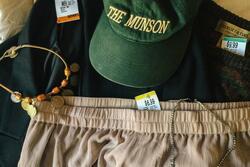Evolution Revolution
I am a member of the Marching Band and Color Guard at my high school. One challenge that we face as a group year after year is designing our costumes. The easy part is making the design fit with the show’s theme. The harder part is designing something to wear that everyone is happy with. There are 25 of us in the guard and we each have a unique body shape, complexion, and sense of personal style. Designing a single outfit that flatters 25 different bodies can be incredibly difficult. While one girl may want to showcase her arms, another may prefer to hide her elbows underneath fabric. Creating a costume that we can all feel confident in is a difficult task. It is incredibly rewarding when we try on the costume for the first time and know that it is one in which we will all feel our best.
I credit my fashion sense to my feminism. I choose to wear clothing that makes me feel comfortable and confident, rather than dressing to fit a certain mold or to please others. I am a Speech and Debate competitor. While many of my peers turn to their power suits, I love to wear a great dress and fun tights. My fashion choice allows me to perform in comfort, and in a style that I embrace. Feminism has taught me that, as a woman, I have the power, right, and responsibility to make these types of decisions for myself, rather than base them on others’ whims.
Fashion and feminism have gone hand in hand for decades. For much of modern history, women’s clothing was incredibly restrictive – corsets and hoop skirts kept women in their place, as society dictated. The overwhelmingly patriarchal nature of society, prior to the early 1900s, insisted that a woman’s place was in the home. Fashion of the time restricted women physically, matching their restricted position in society.
The 1920s marked a revolution, both for fashion and for feminism. After experiencing new freedoms during World War I, such as the ability to hold jobs that were previously reserved for men, and the right to vote, women were more confident than ever that they deserved a higher status within society. As women asserted their newfound independence, what they chose to wear changed as well. Short flapper dresses and high heels marked women who were not afraid to be independent, to do what they wanted, and to dress as they pleased. As the Feminist Movement began to make an impact on women’s daily lives, women were not afraid to dress differently than previous standards dictated.
As the 20th century wore on, fashion revolutions continued to coincide with feminist uprisings. During bra burnings in the 1960s, women literally and symbolically asserted their independence from the patriarchy by destroying this restrictive item. Recently, many feminists have begun rising up against the patriarchy with events such as Slut Walks that protest fashion standards. These walks encourage women to have confidence in themselves, no matter what they are wearing. Again and again, feminists have fought against men who seek to use fashion as a weapon of oppression against women. By doing so, feminists have been able to dramatically improve their own lives, and the lives of women for generations to come.
The freedom that feminism provides through fashion is easily seen at my school. My large public high school truly is a melting pot – students of all different backgrounds, races, religions, and abilities come together to learn. With the wide variety of students comes a wide variety of fashion choices. Some of the girls at my school choose to wear conservative outfits: for example, Indian kurtas and hijabs are often seen in the halls. On the other end of the spectrum there are girls who wear short dresses and tank tops. While girls in these sorts of outfits represent the furthest ends of the fashion spectrum, I think that they demonstrate the impact of feminism because most of the girls at my school probably choose their own clothing. However, this is likely not always the case, even with my classmates. Some of them may be forced by their parents or others to dress in a way that conforms to cultural or religious standards. Others may dress a certain way because they have been told that if they want to be successful, they need to please the patriarchy by conforming to fashion norms. While some girls may not be wearing the clothes that they want to wear, it seems that the vast majority of girls at my school are, and that’s progress!
As American women, we are lucky that, for the most part, we get to choose what we wear every day. Many women around the world are not so lucky. There are still countries and cultures in which men dictate what a woman must wear, and these standards are often enforced with strict punishments for those who choose to break those rules. As a feminist, I feel fortunate that I get to choose what I wear each and every day, but our mission as feminists has not succeeded until every woman around the world has that same freedom.
This piece was written as part of JWA’s Rising Voices Fellowship.







